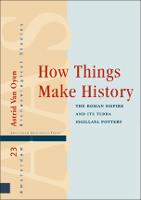How Things Make History
The Roman Empire and its terra sigillata Pottery
| dc.contributor.author | Oyen, Astrid van | |
| dc.date.accessioned | 2020-12-07T09:55:15Z | |
| dc.date.available | 2020-12-07T09:55:15Z | |
| dc.date.issued | 2016 | |
| dc.identifier | ONIX_20201207_9789048529933_9 | |
| dc.identifier | OCN: 1226521935 | |
| dc.identifier.uri | https://library.oapen.org/handle/20.500.12657/43199 | |
| dc.description.abstract | Bright red terra sigillata pots dating to the first three centuries CE can be found throughout the Western Roman provinces. The pots' widespread distribution and recognisability make them key evidence in the effort to reconstruct the Roman Empire's economy and society. Drawing on recent ideas in material culture, this book asks a radically new question: what was it about the pots themselves that allowed them to travel so widely and be integrated so quickly into a range of contexts and practices? To answer this question, Van Oyen offers a fresh analysis in which objects are no longer passive props, but rather they actively shape historical trajectories. | |
| dc.language | English | |
| dc.relation.ispartofseries | Amsterdam Archaeological Studies | |
| dc.subject.classification | thema EDItEUR::N History and Archaeology::NK Archaeology::NKD Archaeology by period / region | en_US |
| dc.subject.classification | thema EDItEUR::1 Place qualifiers::1Q Other geographical groupings: Oceans and seas, historical, political etc::1QB Historical states, empires, territories and regions::1QBA Ancient World | en_US |
| dc.subject.other | Material culture, material agency, terra sigillata, Roman archaeology | |
| dc.title | How Things Make History | |
| dc.title.alternative | The Roman Empire and its terra sigillata Pottery | |
| dc.type | book | |
| oapen.identifier.doi | 10.5117/9789462980549 | |
| oapen.relation.isPublishedBy | dd3d1a33-0ac2-4cfe-a101-355ae1bd857a | |
| oapen.imprint | Amsterdam University Press | |
| oapen.series.number | 23 | |
| oapen.pages | 174 |

